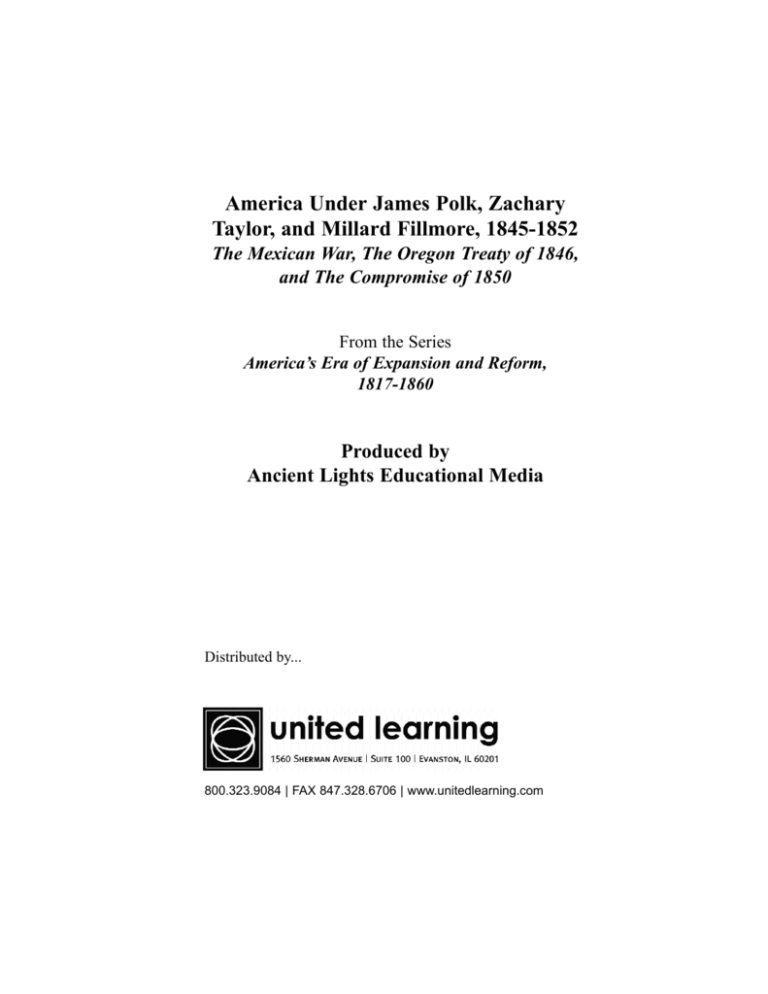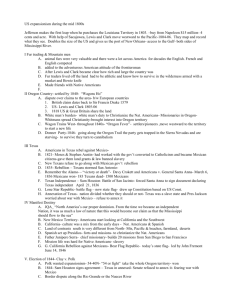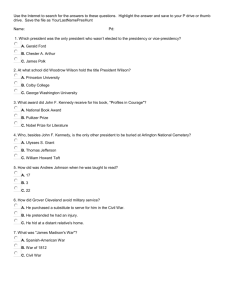America Under Polk, Taylor, Fillmore TG
advertisement

America Under James Polk, Zachary Taylor, and Millard Fillmore, 1845-1852 The Mexican War, The Oregon Treaty of 1846, and The Compromise of 1850 From the Series America’s Era of Expansion and Reform, 1817-1860 Produced by Ancient Lights Educational Media Distributed by... 800.323.9084 | FAX 847.328.6706 | www.unitedlearning.com This video is the exclusive property of the copyright holder. Copying, transmitting, or reproducing in any form, or by any means, without prior written permission from the copyright holder is prohibited (Title 17, U.S. Code Sections 501 and 506). © 2003 Ancient Lights Educational Media Table of Contents Introduction to the Series . . . . . . . . . . . . . . . . .1 Introduction to the Program . . . . . . . . . . . . . . .1 Links to Curriculum Standards . . . . . . . . . . . . .2 Instructional Notes . . . . . . . . . . . . . . . . . . . . . .4 Pre-Test . . . . . . . . . . . . . . . . . . . . . . . . . . . . . .4 Student Preparation . . . . . . . . . . . . . . . . . . . . . .4 Student Objectives . . . . . . . . . . . . . . . . . . . . . .5 Introducing the Program . . . . . . . . . . . . . . . . . .5 View the Program . . . . . . . . . . . . . . . . . . . . . . .5 Discussion Questions . . . . . . . . . . . . . . . . . . . .5 Description of Blackline Masters . . . . . . . . . . .6 Extended Learning Activities . . . . . . . . . . . . . .6 Answer Key . . . . . . . . . . . . . . . . . . . . . . . . . . .7 Script of Narration . . . . . . . . . . . . . . . . . . . . . .9 This video is closed captioned. The purchase of this program entitles the user to the right to reproduce or duplicate, in whole or in part, this teacher’s guide and the blackline master handouts that accompany it for the purpose of teaching in conjunction with this program, America Under James Polk, Zachary Taylor, and Millard Fillmore, 1845 -1852: The Mexican War, The Oregon Treaty of 1846, and The Compromise of 1850. This right is restricted only for use with this program. Any reproduction or duplication in whole or in part of this guide and the blackline master handouts for any purpose other than for use with this program is prohibited. CLASSROOM/LIBRARY CLEARANCE NOTICE This program is for instructional use. The cost of each program includes public performance rights as long as no admission charge is made. Public performance rights are defined as viewing of a video in the course of face-to-face teaching activities in a classroom, library, or similar setting devoted to instruction. Closed Circuit Rights are included as a part of the public performance rights as long as closed-circuit transmission is restricted to a single campus. For multiple locations, call your United Learning representative. Television/Cable/Satellite Rights are available. Call your United Learning representative for details. Duplication Rights are available if requested in large quantities. Call your United Learning representative for details. Quantity Discounts are available for large purchases. Call your United Learning representative for information and pricing. Discounts, and some special services, are not applicable outside the United States. Your suggestions and recommendations are welcome. Feel free at any time to call United Learning at 1-800-323-9084. America Under James Polk, Zachary Taylor, and Millard Fillmore, 1845-1852 The Mexican War, The Oregon Treaty of 1846, and The Compromise of 1850 Viewing Time: 14 minutes with a one-minute, five-question Video Quiz INTRODUCTION TO THE SERIES This standards-based series of programs for grades 5-9 examines the period of expansion and reform that occurred in the United States starting with the presidency of James Monroe in 1817 and continued up to the election of Abraham Lincoln in 1860. The five programs in this series focus on key events that shaped the history of the United States from 1817 to 1860. Major topics examined are: • U.S expansion and how it affected American Indians and foreign powers. • How industrialization, immigration, expansion of slavery, and westward movement changed the lives of Americans and led toward regional tensions. • The extension, restriction, and reorganization of American political democracy. • The sources and character of cultural, religious, and social reform movements in the antebellum period. INTRODUCTION TO THE PROGRAM America Under James Polk, Zachary Taylor, and Millard Fillmore, 1845-1852: The Mexican War, The Oregon Treaty of 1846, and The Compromise of 1850 presents the following topics: • The Presidency of James K. Polk, 1845-1849 • Texas Statehood and Problems with Mexico, 1845 • The Mexican War, 1846-1848 1 • The Oregon Treaty of 1846 • The Presidency of Zachary Taylor, 1849-1850 • The Presidency of Millard Fillmore and the Compromise of 1850, 1850-1853 LINKS TO CURRICULUM STANDARDS The series of which this program is a part is correlated to the U.S. National History Standards, listed below (www.sscnet.ucla.edu) U.S. National History Standard 1 United States Territorial Expansion between 1801 and 1861, and how it affected relations with external powers and Native Americans. Standard 1A The student understands the international background and consequences of the Louisiana Purchase, the War of 1812, and the Monroe Doctrine. Standard 1B The student understands federal and state Indian policy and the strategies for survival forged by Native Americans. Standard 1C The student understands Manifest Destiny, the nation's expansion to the Northwest, and the Mexican-American War. U.S. National History Standard 2 How the Industrial Revolution, increasing immigration, the rapid expansion of slavery, and westward movement changed the lives of Americans and led to regional tensions. Standard 2A The student understands how the factory system and the transportation and market revolutions shaped regional patterns of economic development. 2 Standard 2B The student understands the first era of American urbanization. Standard 2C The student understands how antebellum immigration changed American society. Standard 2D The student understands the rapid growth of "the peculiar institution" after 1800 and the varied experiences of African Americans under slavery. Standard 2E The student understands the settlement of the West. U.S. National History Standard 3 The extension, restriction, and reorganization of political democracy after 1800. Standard 3A The student understands the changing character of American political life in "the age of the common man." Standard 3B The student understands how the debates over slavery influenced politics and sectionalism. U.S. National History Standard 4 The sources and character of cultural, religious, and social reform movements in the antebellum period. Standard 4A The student understands the abolitionist movement. Standard 4B The student understands how Americans strived to reform society and create a distinct culture. Standard 4C The student understands changing gender roles and the ideas and activities of woman reformers. 3 INSTRUCTIONAL NOTES Before presenting this lesson to your students, we suggest that you preview the program, review the guide, and the accompanying Blackline Master activities in order to familiarize yourself with their content. As you review the materials presented in this guide, you may find it necessary to make some changes, additions, or deletions to meet the specific needs of your class. We encourage you to do so; for only by tailoring this program to your class will they obtain the maximum instructional benefits afforded by the materials. PRE-TEST Pre-Test is an assessment tool intended to gauge student comprehension of the objectives prior to viewing the program. Explain that they are not expected to get all the answers correct. You can remind your students that these are key concepts that they should focus on while watching the program. STUDENT PREPARATION Set up a Learning Center with images relevant to the topics presented in this program such as: DMaps and images of battles from the Mexican War and of Texas independence and statehood. DPortraits of James K. Polk, Zachary Taylor, and Millard Fillmore. DMaps showing the Oregon Trail, the Mexican Cession, Division of the Oregon Country by the Oregon Treaty of 1846; maps of the New Mexico and Utah Territories. 4 STUDENT OBJECTIVES After viewing the program and completing the follow-up activities, students should be able to: • Describe events leading up to the Mexican War. • Describe the outcome of the Oregon Treaty of 1846. • Explain the main elements of the Compromise of 1850. INTRODUCING THE PROGRAM Duplicate and administer Blackline Master #1, Pre-Test. Remind your students that they are not expected to know all the answers. Suggest that they use these questions as a guide for taking notes on the key concepts while viewing the program. VIEW THE PROGRAM Running Time: 14 minutes plus a one-minute, five-question Video Quiz. Hand out Blackline Master #3, Video Quiz. DISCUSSION QUESTIONS After viewing the program, you may find it helpful to discuss key concepts as a class. The following topics may prove to be useful. You may also choose to use these topics to begin a discussion prior to viewing the program. 1. Issues leading up to war with Mexico. 2. Issues surrounding the Oregon Treaty of 1846. 3. The process by which U.S. territories were created from new land, and how states were formed from territories. 4. Issues surrounding the Compromise of 1850. 5. Fervor over Manifest Destiny during the 1840s. 6. The California Gold Rush. 5 DESCRIPTION OF BLACKLINE MASTERS Blackline Master #1, Pre-Test, is an assessment tool intended to gauge student comprehension of the objectives prior to viewing the program. Blackline Master #2, Post-Test, is an assessment tool to be administered after viewing the program and completing additional activities. The results of this assessment can be compared to the results of the Pre-Test to determine the change in student comprehension before and after participation in this lesson. Blackline Master #3, Video Quiz, is intended to reinforce the key concepts of the program following the presentation of the program. Student awareness that a Video Quiz will be given also helps promote attention to the video presentation. Blackline Master #4, Crossword Puzzle, is a puzzle game based on information presented in the Vocabulary List. Blackline Masters #5 and #6, Timeline and Activity, presents important events from 1842-1852. Blackline Masters #7 and #8, Vocabulary List and Activity, includes important names, people, places, and terms relating to events that occurred during this era in history. EXTENDED LEARNING ACTIVITIES Field trips to historic sites are the best way to savor the flavor of America's early days. Research papers, oral reports, news reports, or PowerPoint® presentations could be done on the following subjects: 1. The Mexican War. 2. The Compromise of 1850. 3. The Fugitive Slave Law component of the Compromise of 1850. 4. Biographical sketches of Henry Clay, Millard Fillmore, James K. Polk, and Zachary Taylor. 5. The Oregon Treaty of 1846. 6 ANSWER KEY Blackline Master #1, Pre-Test 1. False. U.S. territory increased significantly during that time. 2. True 3. True 4. True 5. True Blackline Master #2, Post-Test Fill in the blanks: 1. James K. Polk 2. California, Utah, New Mexico, Nevada, Arizona, Colorado, and Wyoming 3. Oregon, Idaho, Washington, Montana, and Wyoming 4. Millard Fillmore 5. California Gold Rush The Compromise of 1850: Any three of the five answers listed below: 1. It allowed California to enter the union as a free state. 2. It banned the slave trade in Washington, D.C. 3. It required the U.S. government to buy part of the state of Texas so that it could be transferred to the New Mexico Territory. 4. It allowed people living in the new U.S. territories of Utah and New Mexico to decide for themselves if they wanted slavery. 5. The Fugitive Slave Law forced people in the free states to return escaped slaves to their owners in the South. Blackline Master #3, Video Quiz 1. True 2. False. It lasted from 1846 to 1848. 3. False. It caused the Oregon Country to be divided in half. 4. True 5. False. It was designed to benefit slave owners. 7 Blackline Master #4, Crossword Puzzle 1 T E 2 X 3 F G U A D A L U P E H S I L D A L G O G I T 4 C A L I F O R N I A V 5 M E X I C A N C E S S I O N S 6 7 L T G R E A T B R I T A Y 8 R N V C L A Y O I 9 E 10 F I P L L M O R E A L W K Blackline Master #6, Timeline Activity 1. 1845 6. 1848 2. 1850 7. 1845 3. 1848 8. 1846 4. 1852 9. 1845 5. 1854 10. 1846 Blackline Master #8, Vocabulary Activity 1. Mormons 2. Zachary Taylor, Stephen Kearney, General Winfield Scott 3. Millard Fillmore 4. Louisiana Purchase 5. Sutter's Mill 8 SCRIPT OF NARRATION America Under James Polk, Zachary Taylor, and Millard Fillmore, 1845-1852: The Mexican War, The Oregon Treaty of 1846, and The Compromise of 1850 Between the years 1845 and 1852, three men, James K. Polk, Zachary Taylor, and Millard Fillmore were inaugurated as Presidents of the United States. During this amazing time in American history, the nation underwent some very drastic territorial changes, not seen since the days of the Louisiana Purchase back in 1803. For example, the Mexican Cession brought the United States the lands that now make up almost all of the southwestern part of the country. A treaty with Britain created the Oregon Territory, land that now makes up the entire northwestern part of the county. And to top it all off, the statehood of Texas added even more land. James K. Polk, America's 11th President, 1845-1849 America's 11th President, James K. Polk, was known for being a man who could get things done. In fact, only he and George Washington had such excellent records of success in achieving their political goals. Polk was from Tennessee. He served here in the capitol in Nashville as governor, state senator, and state representative. His home, seen here, was in the town of Columbia, a little south of Nashville, and this was where he lived right up until he moved into the White House. Polk was a Democrat. He favored having slavery and also supported "states’ rights": the idea that states should have more power than the federal government. Upon taking office in 1845, James Polk listed four things he wanted to accomplish as President. The first was to reduce tariffs on imports, the second was to re-establish an independent U.S. Treasury, the third was to settle the dispute with Great Britain over the control of the Oregon Country, the fourth was to acquire California for the United States. By the time his term of office ended, Polk had managed to accomplish every one of his goals. And, beyond that, Texas, Florida, Iowa, and Wisconsin all became states during the presidency of James K. Polk. 9 Texas Statehood and Problems with Mexico, 1845 At the time James Polk was just taking over as President in 1845, Texas, which had been an independent nation for nine years, was going through the final stages of becoming a state. Texans had wanted to become part of the United States even before the famous Battle of the Alamo back in 1835, which had led to Texas independence. But because slavery was allowed in Texas, the northern free states didn't want it to join the United States because Texas statehood would increase the power of the slave states. Late in 1845, a deal was worked out among political leaders and Texas was admitted to the Union as a slave state. Statehood was granted to Texas even though the rulers of Mexico had warned that they would cut political ties to the United States if Texas ever was made a state. But the big trouble that soon developed between the two nations probably could have been avoided if the United States had not wanted the Mexican lands that lay between the Pacific Ocean and America's western frontier. The problem was only made worse by the fact that U.S. leaders were demanding a large sum of money from Mexico for American lives and property lost in that country since its independence from Spain. And the Americans were insisting that the boundary line of Texas was at the Rio Grande River instead of further east where the Mexican government claimed it was. The Mexican War, 1846-1848 A few months before Texas was granted statehood, President Polk sent Congressman John Slidell of Louisiana on a secret mission. Slidell had been instructed to go to the Mexican capital of Mexico City. And, among other things, he was supposed to offer $25 million to buy a huge piece of northern Mexico for the United States. But when the Mexican government learned of his proposal, they were so outraged they refused to talk to him. When John Slidell returned to Washington, D.C., he told President Polk that Mexico needed to be punished for refusing to negotiate. So Polk ordered Army General and future U.S. President Zachary Taylor to take troops into the disputed region 10 of Texas near the Rio Grande River. After Taylor's forces were attacked by the Mexican Army, Congress declared war on Mexico in May of 1846. Oddly enough, out in California a month later, without even knowing that war had been declared, a group of Americans took over the northern headquarters of the Mexican government in the town of Sonoma. As a result of what is called the "Bear Flag Revolt," California was declared to be a republic and independent of Mexico. In July, American marines, sailors, and soldiers arrived by ship and captured both San Francisco and Monterey, the capital of Mexican California. While all that was going on, American forces under Colonel Stephen Kearney were heading down the Santa Fe Trail to invade Mexico from the east. In August of 1846, they captured the old city of Santa Fe, annexed New Mexico to the United States, and moved on to take California. That December, Kearney's troops fought Mexican forces at the Battle of San Pascual near San Diego, California, and were defeated. But a month later, American troops went on to win a decisive battle near the old Spanish Mission of San Gabriel in Los Angeles. And after that, California was firmly in U.S. hands. Throughout 1846 and 1847, American forces plunged deep into Mexico's heartland. They also invaded by ship from the Gulf coast. And after a series of big battles, they captured Mexico City itself. A short time later, on February 2, 1848, the Treaty of Guadalupe Hildalgo was signed, ending the Mexican War. Under the terms of the treaty, Mexico was forced to sell twofifths of its territory, an area of land called the Mexican Cession, to the United States for $15 million. This was the same Mexican territory for which America had offered $25 million a few years earlier. From this land, all or parts of the states of California, Nevada, Utah, Arizona, New Mexico, Colorado, and Wyoming would soon arise. 11 The Oregon Treaty of 1846 In 1846, right after war with Mexico was declared, President Polk was able to gain control of even more land for the United States by working out a deal with Great Britain over the Oregon Country. Back then, this was the name given to a vast region of land jointly controlled by the two nations. It lay to the south of Russian Alaska and to the north of Mexican California between the Rocky Mountains and the Pacific Ocean. The main outpost of civilization in the Oregon Country was Great Britain's Fort Vancouver, a large collection of buildings used in the fur-trading business. But starting in 1843, thousands of Americans began to cross the continent on the Oregon Trail to settle in the fertile Willamette River Valley, just to the south of Fort Vancouver. At that time, the passions of many Americans were being inflamed by the notion of America's "Manifest Destiny," the belief that it was God's plan that the United States should rule all of North America. Although the leaders of Great Britain did not agree with this idea, to avoid a conflict, a compromise was worked out. Under the Oregon Treaty of 1846, the region was divided in half. Britain took control of all the land north of the 49th parallel. And the United States gained control of all the land to the south, which became the Oregon Territory. Out of the Oregon Territory, all or part of five new states, Oregon, Washington, Idaho, Montana, and Wyoming would come to be formed. The Presidency of Zachary Taylor, 1849-1850 In 1849, a new leader moved into the White House. That man was 12th U.S. President Zachary Taylor, hero of the Mexican War. Taylor was a member of the Whig political party that was originally organized to oppose the Democratic Party founded by Andrew Jackson. The year Zachary Taylor was elected, 1848, gold was discovered in California, setting off America's first big "gold rush." Throughout Taylor's time in office, hundreds of ships filled 12 with people hoping to "strike it rich" in the nearby gold fields poured into the harbor of San Francisco, California. Even though Zachary Taylor was a slave owner, he did not want to see slavery expanded in the United States and did his best to stop it. But congressmen from the southern slave states had threatened to break away from the Union if slavery was outlawed in the new territories that were obtained as a result of the Mexican War. At the same time, congressmen from the northern free states threatened military action if that ever happened. But before he could help bring an end to the angry debate over slavery, Zachary Taylor passed away, with two more years in office still left to serve. And so, according to the law, the day he died, Vice-President Millard Fillmore automatically became the 13th President of the United States. The Presidency of Millard Fillmore and the Compromise of 1850, 1850-1853 After Zachary Taylor died in July of 1850, it became the responsibility of the new President, Millard Fillmore, to make sure the issue of slavery on the newly-acquired lands of the Southwest did not tear the nation apart. This task was actually accomplished thanks mostly to the efforts of Congressman Henry Clay of Kentucky. He helped put together five laws, that when taken together, are known as the Compromise of 1850. These laws were designed to appeal to both sides of the slavery issue: those who wanted to stop its spread into the new American territories and those who wanted slavery to grow. The people who were against slavery were pleased with the part of the Compromise that allowed California to enter the union as a free state and also with the law that banned the slave trade in Washington, D.C. And the people who were for slavery liked the part of the Compromise that allowed people living in the new U.S. territories of Utah and New Mexico to decide for themselves if they wanted slavery. And the pro-slavery people were very happy with the Fugitive Slave Law, part of the Compromise, because it forced people in the free states to return escaped slaves to their owners in the South. 13 After he signed the laws of the Compromise of 1850, Millard Fillmore served for a little less than two more years as President. And he was not selected to be the Whig candidate in the election of 1852, which saw Franklin Pierce, a Democrat, elected as America's 14th President. Video Quiz 1. True or False? James K. Polk was once the governor of Tennessee. 2. True or False? The Mexican War lasted for 15 years. 3. True or False? The Oregon Treaty of 1846 spilt the Oregon Country into three parts. 4. True or False? Zachary Taylor died while serving as President. 5. True or False? The Fugitive Slave Law was designed to protect escaped slaves. 14 15 16






